 Finding the right images to support your marketing is difficult. And having so many sources to choose from makes it even harder! But as you may already know, including good quality imagery consistent with your brand is a way to build trust with your buyer and help them decide even faster that you’re the firm they want to work with.
Finding the right images to support your marketing is difficult. And having so many sources to choose from makes it even harder! But as you may already know, including good quality imagery consistent with your brand is a way to build trust with your buyer and help them decide even faster that you’re the firm they want to work with.
Professional photography including images of your team and working spaces are some of the best photographs you can use: but we know now more than ever that this option isn’t always available. So what can you do with stock imagery so it doesn’t look “stocky”?
Here’s how to make sure if you’re using stock imagery, it still connects with your audience and reflects your brand and values:
1. Understand your content first
A common mistake when choosing imagery is to immediately hop onto the search bar without truly understanding the content you’re working on.
This can cause more problems than it solves. Imagine looking for an image for a blog entitled What is the Tax-Free allowance for 6th April 2020 to 5th April 2021. Results will only give you a “Your search did not return any results.” or “Sorry, we couldn’t find any matches.”
Even if you type in “taxes” or “tax allowance”, you’ll still won’t get the type of image you truly want (you’re almost guaranteed to get suggestions of images including calculators and papers and pencils).
Image sites will only show you the most common and obvious images you’ll see on the internet with that title. Every other accountant is probably using the same images on their blogs, social posts or websites for similar content to yours.



You need images that will support the message of your content and relate to your readers. The point of adding images to your content is to explain what’s behind the message easier, faster and clearer than just a cluster of written words.
Start by asking yourself what is your content all about? What emotions do you want people to relate to when they come across it? Think of scenarios or things you can use to symbolise those emotions. Read your content a couple more times and take note of key words you can use when you begin your search.
Think about the main message you want to get across and how the image will be supporting it. Don’t be too literal with your stock photos. The term Tax-Free allowance, for example, doesn’t always equal a cash image.
When people hear tax-free allowance, is it something they can look forward to? Is it something that will make them happy now? How about in the future? Will it help them achieve their long term goals? Will it help them save up for a car or a house? What other things or words can symbolise the term allowance?
Instead of a generic photo of scattered money on the ground, think a little differently about what’s behind the message of your post. For example, what about an image of little banks of coins labelled house, travel and car – showing the message of saving up? Or an image of an old couple who looks happy and comfortable, free from worries because they have saved up their tax-free allowances through the years?
 Likewise, the phrase running out of time doesn’t always equal a generic clock image. Find out what’s running out of time? Why is it happening? What emotions does it imply? What will be the result when time is up? Will it cause frustration or happiness? It could turn out to be a positive or a negative thing.
Likewise, the phrase running out of time doesn’t always equal a generic clock image. Find out what’s running out of time? Why is it happening? What emotions does it imply? What will be the result when time is up? Will it cause frustration or happiness? It could turn out to be a positive or a negative thing.
Get to the bottom of what your content is all about. It’s not just about cash or time: there’s always a deeper meaning behind every image you use for your content.
Make sure there is a connection between the image and content
Think about the message you want people to clearly see. Get ideas from it and come up with keywords to use when searching for images. Dig deep but make sure the connection between your image and content still exists.
If someone were to only see the image, will they understand the message you are trying to convey? Your readers must be able to relate the copy they just read to the image you’ve chosen. There’s no point if you’re the only one who gets the connection between the image you’ve chosen and your content.
With the running out of time example, don’t pick an image of an old, dying tree just because running out of time can mean getting old and weak.
Say the main message turns out to be about making sure to hit a certain deadline. A dying tree is way off the main message. Pick something that is more lighthearted and still easy to relate to. Like a person who’s out in the open with arms up in the air. An image showing a person celebrating freedom and gives the message of feeling accomplished.
Do not make your readers think too hard and too far from the actual meaning of your content but instead make it as easy as possible for them to understand the actual meaning quickly.
2. Remember who you are trying to attract (back to who is your target audience)
Finding images relating to your content is important, but choosing images which are appealing to your target audience is even more important.
Images build connections through emotions and messaging. What you want is to build trust with the right audience and help them connect with you better.
Increase their familiarity by using consistent messaging not only with words but also with imagery. Make sure to use images that reflect your firm’s brand, style and values so it appeals to the types of clients you want to be working with.
Pink Pig Financials has built connections and solidified their brand identity through consistent imagery. Their content is easily recognisable because of their clear brand. They use lots of their own pink pigs icons and family themed images with their content. They are always on brand and it appeals to their clients (working families).
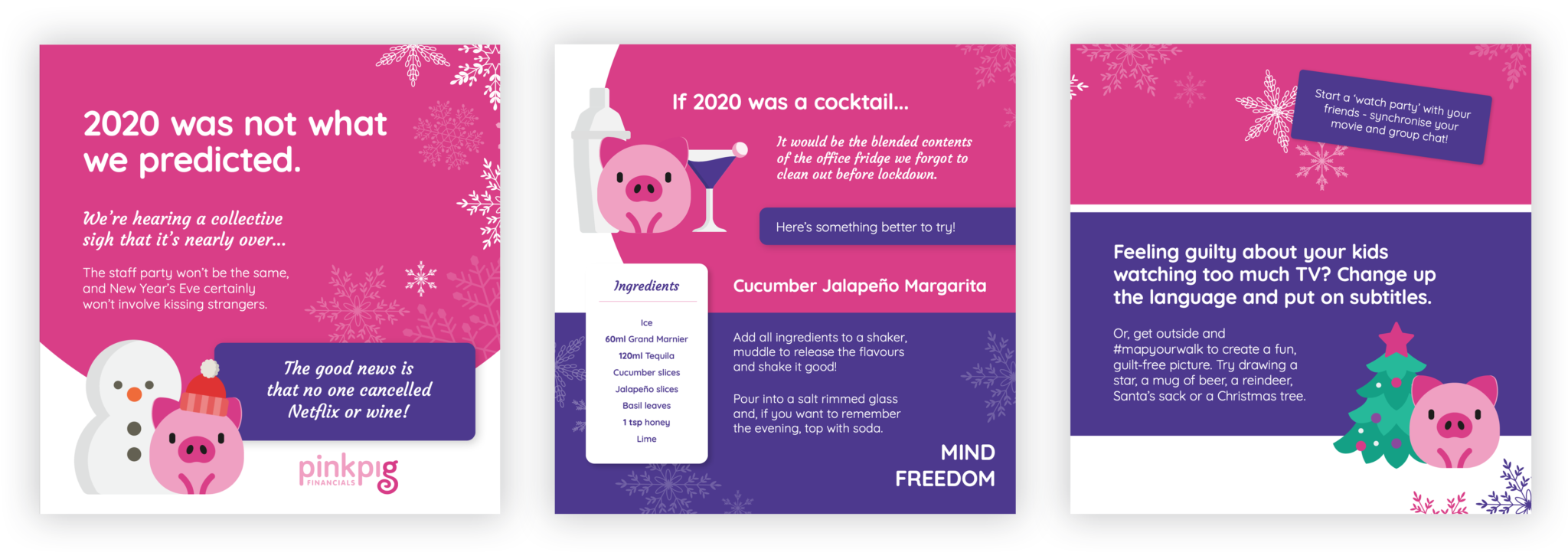
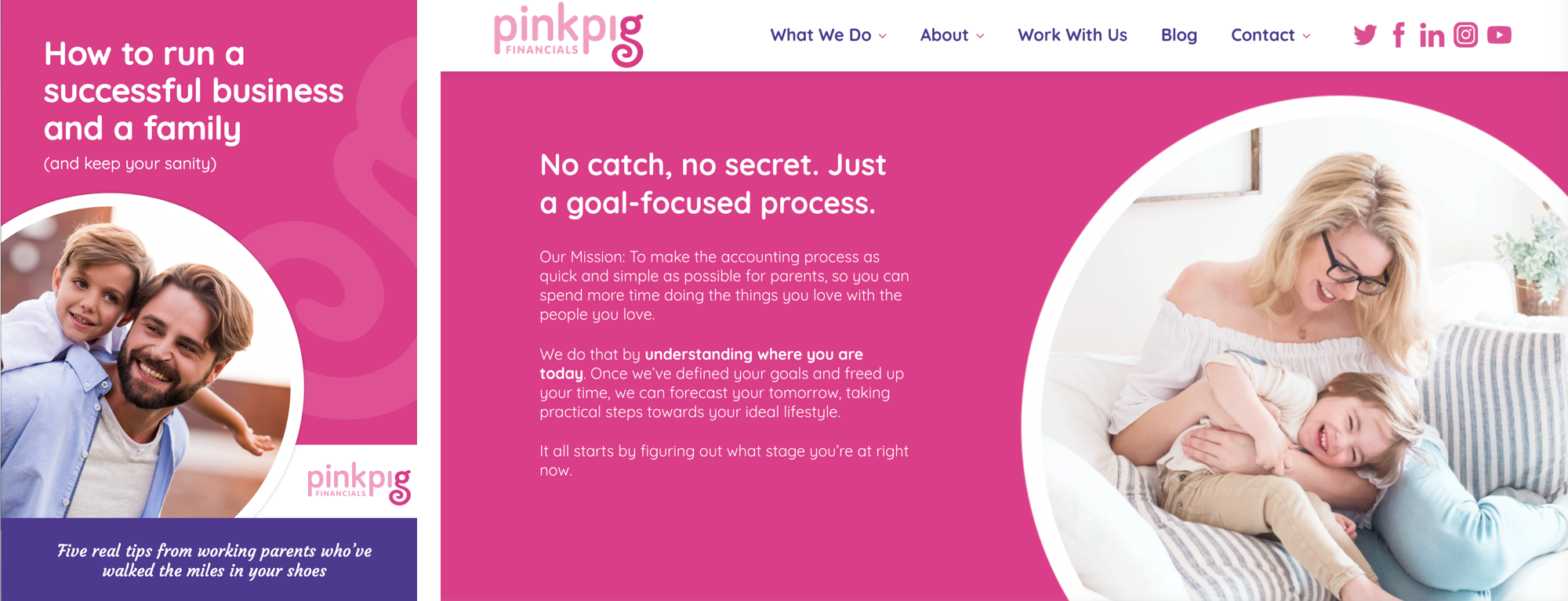
3. Think of where and how the image will be used
We know you’re excited to get your content published with perfect imagery, but hold your horses. You would not want to get stuck in a cycle of scrolling through hundreds of photos, picking a few to download, trying to fit them in your layout and end up scrolling again because they just don’t look and sit right with the content.
Lay out your content. Arrange and group elements until you’re happy with how they’re placed. Will the copy look better on the left, right, below, above or over the image? Will it look better if the image is cropped into a circle or a different shape? Answering these simple questions will help you get a better idea of what images you really need. You can always go back and change the layout if you get inspired by a different idea while you were searching for images.
Imagine the image cropped into a square, a rectangle or a circle. Will doing so cut the main focus of the photo? Does it have enough space around the edges so you can zoom in and out without losing the subject? You want to make sure you have room to crop and scale the image without having to worry about fitting it in your design.
The placement of an image can make all the difference when choosing the right one. If you plan to add text or other elements around the image, you’ll want to pick an image with a subject that has plenty of breathing space around it. The less crowded it looks with the other elements, the easier your readers can understand the message you’re trying to convey.
Don’t forget to also check how much content you have so you know how many images you need to download. A blog will need a feature image and maybe a few more images throughout the content as needed. A tweet on the other hand, will only need one image to grab people’s attention as they scroll through their feed. Depending on how much content there is, you might need several images to break up the content.
Imagine how much time and effort you can save if you already have an idea of what kind and how many images you will be looking for from the start. The faster and more efficient you choose the right images, the faster you can get your content out there.
Where exactly is the image going to be used?
- Instagram: the most visual platform. You want the image to stand out and be quickly understandable and closely relate to your brand so that people instantly recognise the image. Also keep text to a minimum – we suggest less than 20 words on your image so you get to the point quickly and people can read the caption for more information.
- Twitter and Facebook: people scroll through tweets a lot quicker compared to other platforms. Most will spend only several seconds looking at the image and so it needs to be super quick to understand.
- LinkedIn: a platform where people don’t tend to use images too much since text-only and video posts are more prioritised. If you do want to post images, keep them more professional and on brand. People become more familiar with your firm because you stand out with your own brand amongst others.
- Website: needs to be well thought out and not only reflect your brand, but also your values and what you stand for. I.e. if you want to show your human side, feature more people. If your niche/focus is local business then you could feature pictures of the local area. If you are not yet sure about your brand, PF can help you review your branding in line with your website in a foundations workshop. It makes choosing the right images easier once you get a clearer look at your brand.
- Blog: Think about the content: imagine if someone only saw the image on the blog. Would they understand what the blog was about?
Remember, you can reuse images to help build brand awareness and consistency but tweak them slightly for different platforms.
How is the image going to be used?
Decide what you want your viewers to focus more on – the image or the copy. Who is the main star and who is the supporting act? If you want the copy to be the main star of your design, pick a less striking image with enough negative space to accommodate the text. Look out for a flat area in the image where there is good contrast between the background and text. Avoid crowded images with busy patterns and elements when adding text over images.
Look at Saint & Co’s featured image on their homepage. The sky area works really well as a space for the text. The image is not crowded and we can still read the copy easily.
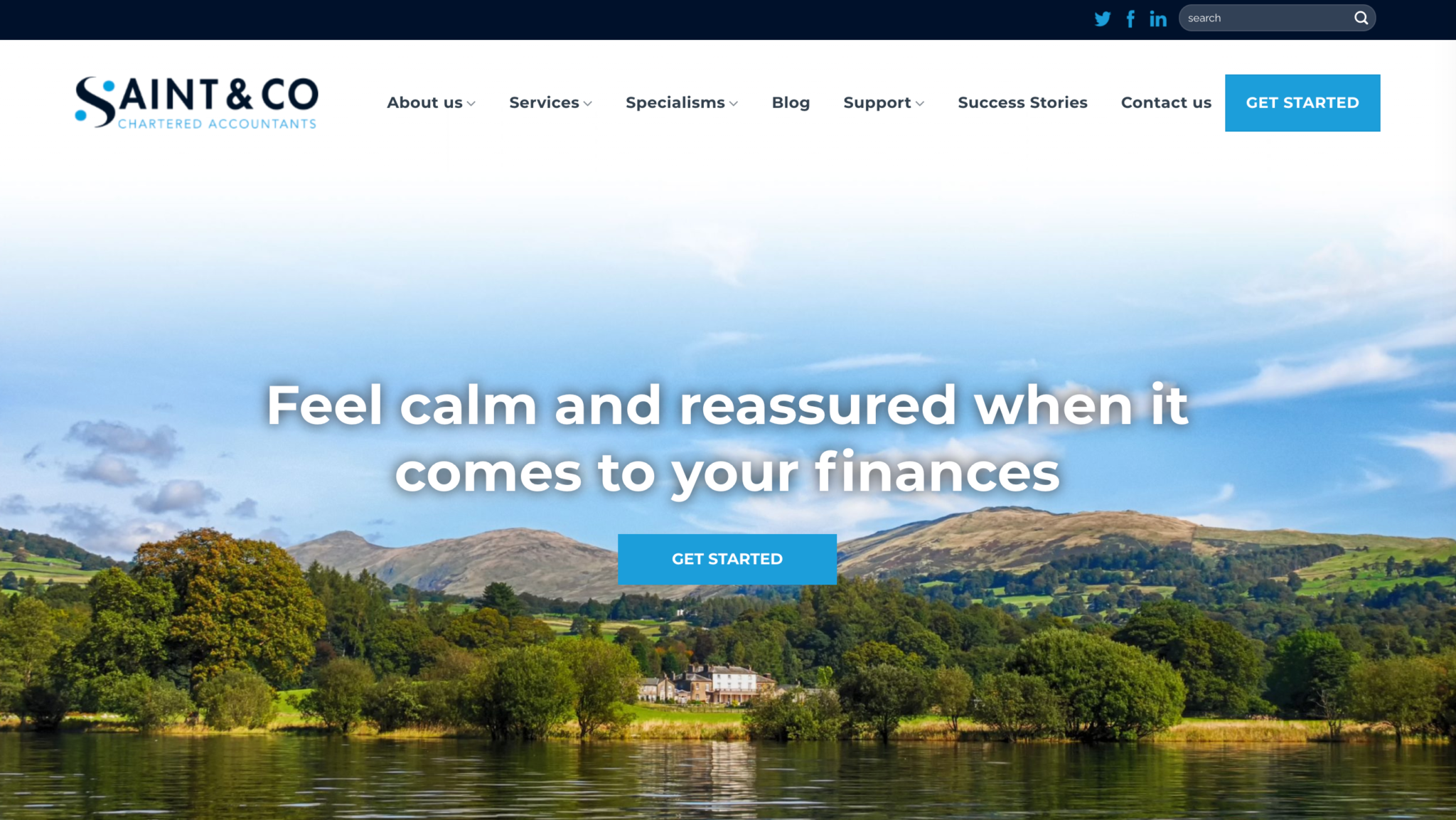 Sometimes, you might struggle to find the perfect image with enough negative space to put text on. One common design technique is to add a colour overlay on the image. This allows the text to be more prominent without the need to add strokes or shadows in your designs.
Sometimes, you might struggle to find the perfect image with enough negative space to put text on. One common design technique is to add a colour overlay on the image. This allows the text to be more prominent without the need to add strokes or shadows in your designs.
 Brighter images are better to add colour to so avoid dark photos for overlays. The initial colours of the photo won’t really matter for overlays, so it’s better to focus on what the image means or represents. Make sure people can identify what the image is all about the moment you look at the photo because once you add the overlay, the image becomes harder to distinguish.
Brighter images are better to add colour to so avoid dark photos for overlays. The initial colours of the photo won’t really matter for overlays, so it’s better to focus on what the image means or represents. Make sure people can identify what the image is all about the moment you look at the photo because once you add the overlay, the image becomes harder to distinguish.
You can make stock imagery custom for your firm.
Did you know when you choose a stock image, you don’t have to use it exactly as is? You can have it edited by a designer so it’s roughly the same image, but it’s more catered to your brand and the concept you have in mind for your content.
If you find an image that’s totally off your brand colours but perfectly fits the message you want to convey, you may alter the photo a little so it fits your brand better. Make sure you have common rights to the photo, if not, we advise you purchase it before doing so.
Red, for instance, is a very eye-catching colour. Unless it’s part of your brand and strategy, it’s very tricky to use images with large areas of red because it can take all your viewer’s attention away from the main focus. Recolouring the area into one of your main colours will make the image more usable and fitting to your brand.
 It can also be the case of changing text or other elements in the photo to avoid confusing your readers with the message it originally has. A photo of a laptop with some random website on the screen can be edited to show a sneak peek of your website instead. Simple edits can make a stock photo more appealing and memorable.
It can also be the case of changing text or other elements in the photo to avoid confusing your readers with the message it originally has. A photo of a laptop with some random website on the screen can be edited to show a sneak peek of your website instead. Simple edits can make a stock photo more appealing and memorable.
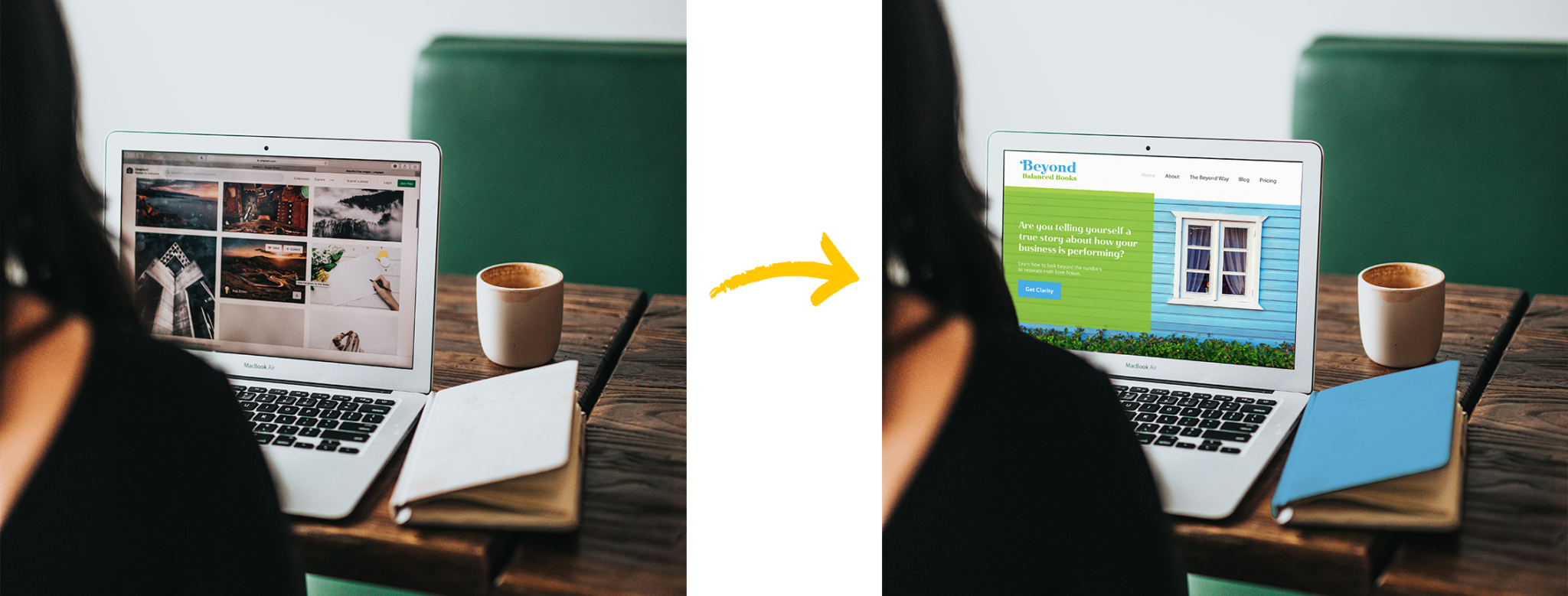 PF can create you a bank of stock images that we’ve edited to be custom to your brand. Edits may include adding your brand colours, your fonts and any relevant text. The image will originate as a stock image, but some will be edited to suit your brand.
PF can create you a bank of stock images that we’ve edited to be custom to your brand. Edits may include adding your brand colours, your fonts and any relevant text. The image will originate as a stock image, but some will be edited to suit your brand.
Time to start searching!
Where do I start my search?
There are many image library websites out there and it can be difficult to find reliable ones to download images from.
Ideally, you want to look for high quality, professionally-taken images for free, and often with no barriers on where they can be used. Even better to find unusual yet relatable images that other accountants won’t be using.
Here are the top free image websites we suggest:
Pixabay – This is a great all rounder: includes photographs, vectors and illustrations.
Pexels – Great selection of business images, including most industries. The search function works really well for a free site.
Unsplash – Really beautiful high-resolution photography images. We love the inspirational and adventurous travel images. Be warned you’ll want to book a trip somewhere!
We also use paid sites when we need a more specific image quickly, or when we can’t find one on a free website. Paid sites have a much larger collection of images – from custom graphics to photography. The search function also tends to be a lot better so you’re bound to find an image which will work.
123rf – Large selection of images with a low cost payment option.
Envato.elements – A great all rounder: not only images but other resources like videos, background music, mockup templates, fonts, etc. Reasonable subscription price.
Adobe Stock – As a new user, you get 10 free images within a 30-day free trial. They have a wide range of high-resolution images and videos to choose from. It can get pretty expensive but you’re sure to get only high quality resources.
Shutterstock – Well known site with a huge collection of images and videos. This can become quite expensive too.
Canva – You can get unlimited access to their wide range library of graphics, photographs and design templates if you upgrade your free account to premium. We think the upgrade is worth-it especially if you’re enthusiastic about creating and customising your own images.
Use the right search terms
Looking for images can be fun but also tedious. You type in your first keyword, scroll down, pass several images and then you find the perfect image on the first page.
Lucky you!
It’s pretty rare to find the right image on your first try. Most times, you’ve reached page 5 and still haven’t found what you’re looking for.
That’s when you know you need to enter a new keyword in the search box.
The photo needs to be relevant to the copy (or to the brand) in any way possible. Pull out tangible ideas or objects from the copy and type in the search button. Scroll through the images and save a couple of images you think might work.
Whilst scrolling, you will come across an even more specific object that’s also related to your copy. Click on the image you think best fit your requirements and you’ll see even more suggested images at the bottom of the page.
You may also type it in as a new keyword in the search box. Scroll and repeat until you find the right image. If you’re not sure, do some more search using other keywords that came up until you get enough options. That way, you get a variety of images, not just the obvious images that everyone else uses.
Searching for stock images can be the task that never ends. You could spend literally hours searching for one image: and that is NOT a good use of your time. We suggest putting a literal timer on it: set 5 minutes on your phone, and when the timer goes off, either pick one of the options you have already, or use one more minute to pick one and then move on. Think about the value of your time and what you (and only you) are able to do with that time. If it takes longer than 5-10 minutes, either just pick something, or hire someone to do it for you. You could even ask PF to help you build a miniature “Your custom stock imagery” library with 10-15 images to fit your brand and colours. Request a quote for that here.
Don’t forget about filters
Almost all image libraries will allow you to filter results by type, size, orientation and even colour. Some sites also provide suggested tags that are related to your keywords. You also have the option to sort the results from newest to oldest, most relevant and most popular. Use these search features to help you find more specific images amongst thousands of choices. They are especially handy when using generic or keywords.

Narrow your search. If you are looking for photographs, choose the option for photography. If you’re using a keyword you’ve used many times before and have scrolled through a lot of the same photos already, it might be better to sort by Newest instead of Relevance so you get to see a new batch of results.
Pick high resolution images
As much as possible, go for high resolution images.
A very obvious tip, we know. But there are still some of us who disregard the quality of the image we use for our content.
It’s in human nature to link the quality of the images you use to the quality of your firm and products. A really great photo can turn a decent idea into something that’s truly special. It’s like saying, what you see is what you get. It can build trust instantly.
The ideal size for web images can range between 1080 to 2500 pixels wide. More than can cause social media platforms to compress them. Less than can also risk displaying a blurry and pixelated image.
If you plan to print the image for business cards, posters, billboards or signage, you’ll need to make sure the image is high quality enough for print – more than 300 dpi (dots per inch).
Remember your brand
It’s harder now more than ever to get people to capture and retain attention spans. You need to help your audience consume your content easier and faster so they can remember you.
Pick images with your brand in mind to get more engagement. Make your content memorable by using images with things in your brand colours. Look for subjects, objects and even places your target audience see (or aspire to see) in their everyday lives and stick to that similar theme for all of your visual contents as much as possible.
A well-made content matched with a well-thought image is more likely to resonate with your audience over time, eventually leading to building trust and connections with your target audience. You want people to recognise you and feel familiar every time they come across your posts.
Saint & Co. whose several offices are located near the Lake District, uses imagery to solidify their brand identity. It made total sense for them to use nature photos, lots of mountains and lakes, so their clients and prospects can get the idea of where they are and how it might be to work with accountants in the area.

Don’t settle for stock
You’ve probably heard us many times: “Avoid stock photos”. Yes, avoid them when you can as they can feel too generic.
A workaround for stock photos is to choose the ones that least feel scripted or fake. A person’s clothing, facial expression and body angle, for instance, can make a whole lot of difference when choosing the best stock photo.
 All three photos above are high quality, and though it’s the generic “handshake” photo, they are okay depending on how and where they will be used. Which of the three images do you think is the least stocky?
All three photos above are high quality, and though it’s the generic “handshake” photo, they are okay depending on how and where they will be used. Which of the three images do you think is the least stocky?
I’d pick the photo in the middle.
It has the most natural and least fake feeling out of the three. The shot was taken almost in the view of one of the subjects, showing a hint of expression from the other person. It has a bit more story to it than just hands shaking. It’s not in the generic front angle unlike the other two which look really stiff and scripted. Suits also adds that “stocky” vibe which we all know is very common to mean “business” and “corporate”.
Remember, we want our audience to be able to relate your content to the image. Not just for display but to enhance your message. If you feel those front angled handshake photos are perfect for your content, you might want to go back to point 1 of this tip and figure out the real message of your content.
You also have the choice to alter parts of an image so it fits your concept. Some change in colour or lighting can make a photo less stocky. Others can be cropped to a certain point to get rid of any generic elements in the photo.
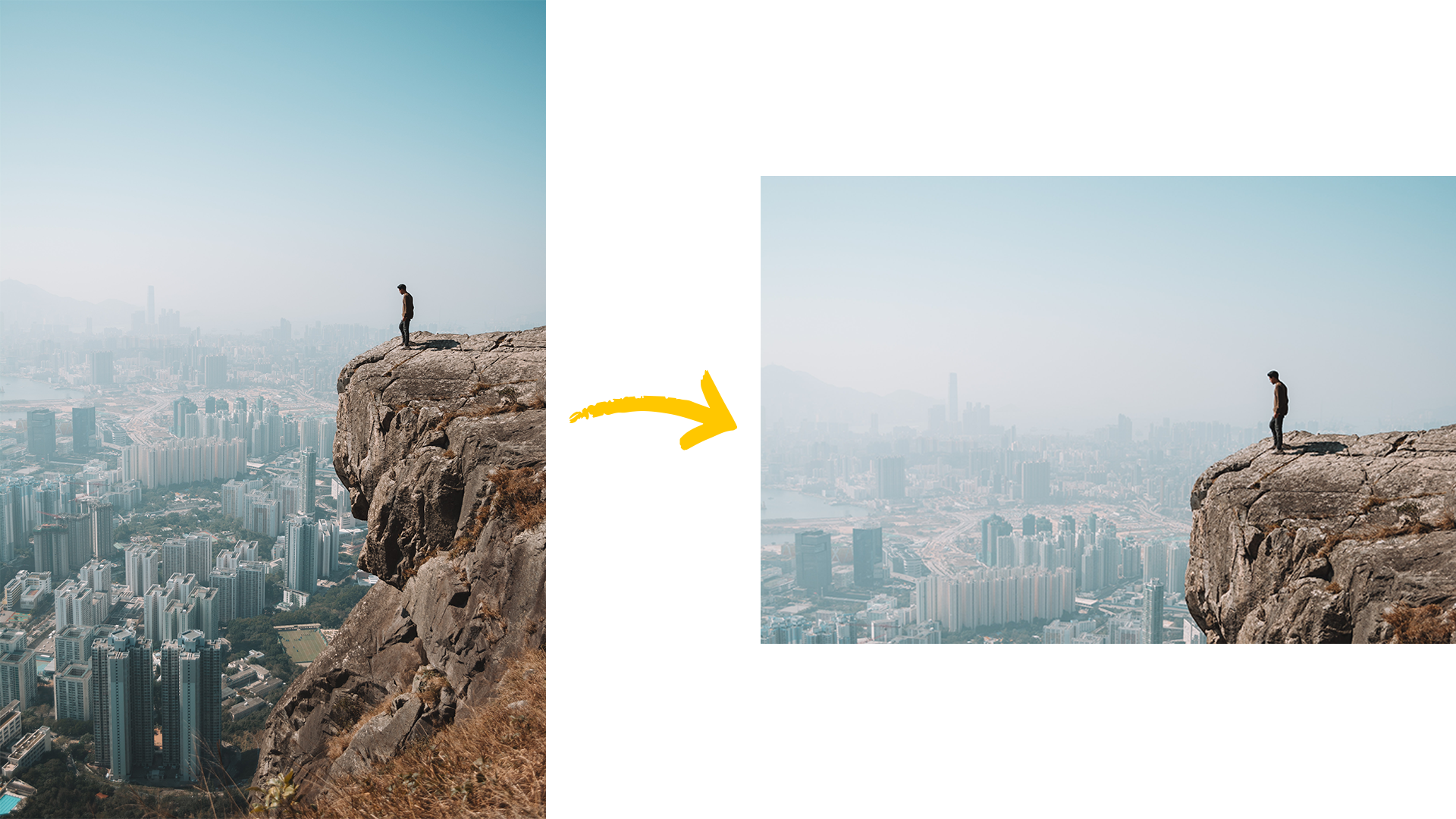
Take the images above as an example to describe success. If we look at the image on the right, we can clearly see the guy standing on a very high place. We can say he has reached the top; he is successful.
Now, look at the photo on the left. If not cropped shorter, the distance from the ground up to where he is can be seen and can feel daunting. There is a slight difference in the message it then conveys: the more successful you are and the higher you go, the deeper and harder you fall.
There you have it! Remember these tips each time you are choosing stock imagery. The process will get quicker and quicker each time you do it. You’ll start to see patterns in the style of imagery you are choosing. Always remember to choose images that reflect your brand and content to appeal to your target audience. Get in touch with us by filling in the form if you’d like help in creating a custom stock image library for your firm.

